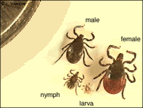Over at Doc Around the Clock, Dr. IBear has a nice post on Lyme disease: what it is, what it's not, and how to deal with ticks (appropriately, not as his mom removed them). He mentions this:
Most of the time people who get Lyme disease don't even know or remember being bitten by a tick. Thus, it stands to reason that if you do remember being bitten by a tick you probably don't have Lyme disease.
I want to elaborate on this just a bit, below.
A reason many people don't realize they've been bitten is because when the tick bites the human to transmit the Borrelia spirochete, it's not always a full-grown tick that does the biting.
 Ticks undergo a complex life cycle with a series of molts (egg --> six-legged larvae --> 8-legged nymph --> 8-legged adult tick). WIth the obvious exception of the egg stage, at each other part of the life cycle, the tick needs a blood meal. Typically in the early stages, that meal will come from smaller animals, such as mice or other rodents. This is where the tick picks up Borrelia burgdorferi: from species such as the white-footed mouse Peromyscus leucopus and others that act as the reservoir of the bacteria. Once the tick is infected, it remains so for life, spreading the bacterium when it bites--and so, subsequent hosts may also become infected. The human is one of these. Typically, we're an "accidental" host--in many areas where Lyme disease is endemic, ticks prefer to feed on deer (and hence, the importance of this animal in maintaining the tick population in the region). Now, even adult ticks are pretty small.
Ticks undergo a complex life cycle with a series of molts (egg --> six-legged larvae --> 8-legged nymph --> 8-legged adult tick). WIth the obvious exception of the egg stage, at each other part of the life cycle, the tick needs a blood meal. Typically in the early stages, that meal will come from smaller animals, such as mice or other rodents. This is where the tick picks up Borrelia burgdorferi: from species such as the white-footed mouse Peromyscus leucopus and others that act as the reservoir of the bacteria. Once the tick is infected, it remains so for life, spreading the bacterium when it bites--and so, subsequent hosts may also become infected. The human is one of these. Typically, we're an "accidental" host--in many areas where Lyme disease is endemic, ticks prefer to feed on deer (and hence, the importance of this animal in maintaining the tick population in the region). Now, even adult ticks are pretty small.  Nymphs are smaller, and larvae are very hard to see, even when you're looking. So it's not just because ticks are small that you don't notice their bite; it's because the immature ticks are even smaller and less conspicuous. The images to the left are shown actual size; you can see that, while you may not notice an adult tick, even careful checking might miss a larvae or nymph.
Nymphs are smaller, and larvae are very hard to see, even when you're looking. So it's not just because ticks are small that you don't notice their bite; it's because the immature ticks are even smaller and less conspicuous. The images to the left are shown actual size; you can see that, while you may not notice an adult tick, even careful checking might miss a larvae or nymph.
Imagesfrom http://www.afraidtoask.com/images/tickdimecycle.gif and http://www.afraidtoask.com/images/ixodessize.gif

I got Lyme disease when I first came to the USA. I had a tick, I removed it, got a target-shaped rash, went to the ER, got antibiotics (tested positive in the meantime) and am still alive and well 15 years later. Luckily, my wife (at the time still wife-to-be) knew all about it and made me go to the doctor - I had never heard of Lyme disease back in Europe.
Ticks. What could the Intelligent Designer have had in mind when it made them? We are overrun with them this year. Fortunately, at least so far, Lyme and Rocky Mt are not common here.
A great point to make, re: the easily unnoticed nymphal-stage ticks, which transmit the vast majority of Lyme disease in humans. Also of note is the fact that while adult ticks prefer deer, nymphs prefer small rodents like mice and chipmunks. Researchers have recently found that the key to Lyme disease risk is the rodent population, not the deer population as was previously thought.
"Most of the time people who get Lyme disease don't even know or remember being bitten by a tick."
True. Only 20% are aware according to a study cited in the Wikipedia-Lyme disease article. Another reason for this, in addition to the small size of the tick in its nymphal stage, is that the tick secretes chemicals that act as an anesthetic, so you don't feel the bite at all.
But back to Dr. Ibear's quote:
"Thus, it stands to reason that if you do remember being bitten by a tick you probably don't have Lyme disease.
Huh? Awareness of tick bite is independent of whether or not the tick carries Lyme. The only way noticing the bite reduces your risk of contracting Lyme disease would be if you pulled the tick off before it has a chance to transmit the infection (the time is disputed, but the risk is certainly greater at 24 hrs and beyond; if the tick is engorged, concern is most definitely warranted).